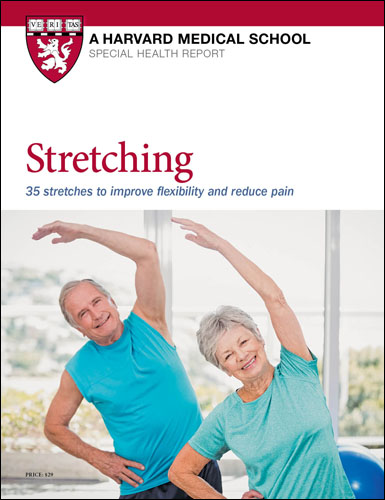Drug-free solutions for pain
Worried about drug dependency for managing persistent or recurring symptoms? These strategies offer a natural alternative.
- Reviewed by Howard E. LeWine, MD, Chief Medical Editor, Harvard Health Publishing; Editorial Advisory Board Member, Harvard Health Publishing
 Everyone has the occasional ache, pain, or soreness in a muscle or joint. A dose of over-the-counter pain medication like acetaminophen (Tylenol) or a nonsteroidal anti-inflammatory drug, such as naproxen (Aleve) or ibuprofen (Advil), often does the trick. But what if you battle recurring discomfort in your back, shoulders, knees, or hands that interferes with your quality of life? You might require extra doses or even a more powerful prescription pain reliever.
Everyone has the occasional ache, pain, or soreness in a muscle or joint. A dose of over-the-counter pain medication like acetaminophen (Tylenol) or a nonsteroidal anti-inflammatory drug, such as naproxen (Aleve) or ibuprofen (Advil), often does the trick. But what if you battle recurring discomfort in your back, shoulders, knees, or hands that interferes with your quality of life? You might require extra doses or even a more powerful prescription pain reliever.
Unfortunately, relying on pain pills can come with its own problems. "There's no free lunch with pain drugs, whether over-the-counter or prescription. There's always some potential downside," says Robert Jamison, a clinical psychologist and professor at Harvard-affiliated Brigham and Women's Hospital's Pain Management Center.
These potential pitfalls include side effects, such as upset stomach, nausea, constipation, or dizziness, which can increase your fall risk. There's also the issue of drug dependency. "Some people feel uneasy about becoming too reliant on continuous pain medication to function and live their normal life," says Jamison.
Finding new options
A possible solution to the pain pill dilemma? Try any of the many available drug-free pain relief options. "These can help alleviate your pain, make it easier to manage, possibly even treat it," says Jamison. Here is a look at some common drug-free remedies and the kinds of pain they target. Some can be self-administered; others must be performed by a certified professional.
Keep in mind that these treatments work for some people and not others, and their overall effectiveness can vary. "Still, they don't possess any significant downside and could be worth exploring," says Jamison. Also, remember that lingering pain or pain that worsens over time is your body saying something is wrong and should be checked out. "Never think that pain is something you simply have to live with," says Jamison.
Physical therapy. Physical therapy can be a practical first step in addressing many common sources of pain, such as in the back, knee, or shoulder. A therapist works with you to create individualized exercises, stretches, and postures that help relax tight muscles, reduce joint pain, and improve range of motion.
Massage therapy. A substantial body of evidence supports massage therapy for treating pain. A review of research published May 9, 2019, in The Journal of Alternative and Complementary Medicine cited several high-quality studies that endorse its use for low back, neck, shoulder, and muscular pain. What's not clear is whether a particular style of massage therapy or number of sessions is best. Many therapists focus their work on clients recovering from injuries or surgeries. These professionals may also have specialized training in massage for conditions like back and neck pain.
Yoga. A review of existing research published in the September 2020 NCCIH Clinical Digest found strong evidence that yoga can help relieve low back pain and has some success in lessening discomfort associated with knee osteoarthritis, rheumatoid arthritis, and neck problems. Many yoga studios and community centers offer specialized classes for addressing specific types of pain.
Acupuncture. An acupuncturist inserts hair-thin needles into a patient's skin at various points thought to fall on pathways in the body called meridians. The needles are meant to stimulate nerves and release blocked energy called "qi" (pronounced "chee") that may contribute to pain. Some studies have found acupuncture helps relieve low back and knee pain, migraine, and fibromyalgia, while other research has shown no benefit. For most people, it takes several treatments to feel results. A form of the therapy called electroacupuncture sends low electrical currents through the needles. This approach was found equally effective as traditional acupuncture for treating low back pain, according to a study in the June 2020 Journal of Acupuncture and Meridian Studies.
Breathe out the painWhen you need fast-working relief for a painful flare-up, try belly breathing.
|
Transcutaneous electrical nerve stimulation (TENS). With TENS, a small battery-operated device transmits a small electric current through conductive pads that a clinician applies to the skin over the painful area. The current creates a tingling or pulsing sensation believed to disrupt pain signals from nerves. It is often used to treat persistent pain in the low back, neck, or shoulder. According to Jamison, evidence is mixed regarding the effectiveness of TENS, but it's relatively safe for most people. However, people with pacemakers should avoid it.
Cognitive behavioral therapy (CBT). Pain is often made worse by our reactions to it, such as worry, stress, and anxiety. "CBT can help manage how you think and react to pain," says Jamison. "It doesn't directly address the cause of your pain, but it may diminish the perception of its severity and perhaps prevent future episodes." With CBT, you learn how to challenge negative thoughts. The therapist helps you explore your negative thinking patterns to discover what triggers the thoughts and how you react to them. Taking this information into account, the therapist develops strategies for you to use when managing pain.
Biofeedback. Often used in conjunction with CBT, biofeedback involves learning to control physiological processes — such as muscle tension, blood pressure, or heart rate — that occur in response to pain. During a typical session, electrodes attached to the skin monitor your reaction to different stimuli. The therapist helps you implement mental routines and relaxation exercises to counter negative responses. Through a trial-and-error approach, you learn to change your reaction when faced with pain or discomfort.
Image: © Karl Hendon/Getty Images
About the Author

Matthew Solan, Executive Editor, Harvard Men's Health Watch
About the Reviewer

Howard E. LeWine, MD, Chief Medical Editor, Harvard Health Publishing; Editorial Advisory Board Member, Harvard Health Publishing
Disclaimer:
As a service to our readers, Harvard Health Publishing provides access to our library of archived content. Please note the date of last review or update on all articles.
No content on this site, regardless of date, should ever be used as a substitute for direct medical advice from your doctor or other qualified clinician.
















